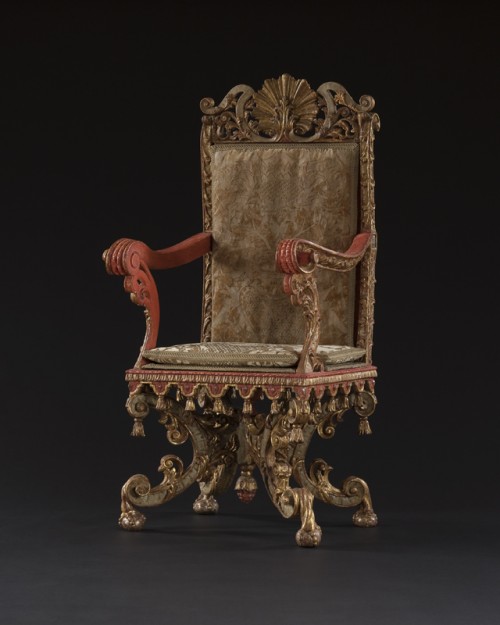9745 A MAGNIFICENT RÉGENCE PERIOD RED PAINTED AND GILTWOOD ARMCHAIR Probably Venetian. First Quarter Of The Eighteenth Century. Measurements: Height: 50 3/4″ (129 cm) Width: 25 1/2″ (65 cm) Depth: 22″ (56 cm)

Research
Of giltwood with red painted decoration. The undulating rectangular back surmounted by a pierced shellwork and foliate crest. The reverse of the backrest is decorated with a system of carved giltwood bandwork and trellis pattern on a red painted ground. From the back issues two voluted and scrolling arms resting on shaped foliate supports. The rectangular seat with carved lambrequin apron rests upon a foliate carved double x-form base, terminating in carved claw and ball feet. The base reinforced, minor replacements to the carving, gilding original with some refreshments to worn-through high points. The upholstery of the back and seat is recent, however, the fabric is 19th century.
The present armchair is an example of the exuberantly carved and vividly colored chairs being created in the early part of the eighteenth century to furnish the enchantingly sensuous palazzos of Venice, then “an enchanted city of carnivals, masques, amusement and pretence.”1 It takes the modified form in which the high-backed chair of the renaissance persisted into the eighteenth century, ranged with cabinets and tables against the walls of the grand formal rooms of Italian palazzos. Throughout Italy the predominantly rectilinear form of these chairs was given more exuberant expression through the ornate carving, gilding and the application of often vivid color seen in the present chair.
The overall form of the chair with a boldly carved scrolling stretcher and the use of the shell motif, was especially characteristic of Venetian craftsmen. Increasingly, these chairs were highly decorated objects made colorful with the addition of paints or gilding, in the use of which Italian craftsmen excelled. The taste for gilded furniture, begun in the last decades of the seventeenth century, reached its highest expression in Italy, whilst it was particularly in Venice, with the use of what the furniture historian William M. Odom terms “exquisite harmonies” of color, that the art of furniture painting was most completely mastered and beautifully employed.2
Footnotes:
1. William M. Odom, A History of Italian Furniture, Volume II, New York: Doubleday, Page & Company (1919), p.102.
2. Ibid., pp. 159-162, p. 189, p. 204.



Comments are closed.